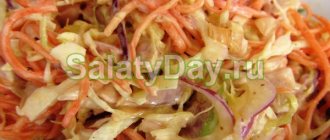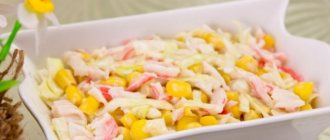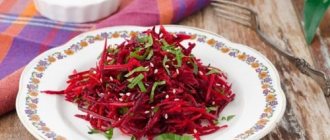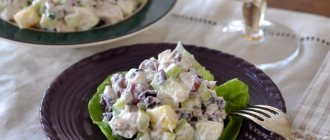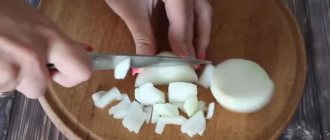Pickling cucumbers and tomatoes is a favorite pastime of Russians at the end of the summer season. It is at this time that zealous housewives try to replenish their supplies of canned vegetables in order to delight their loved ones with original snacks and salads all year round. From our article you will learn how to properly pickle cucumbers and tomatoes for the winter. Recipes for canned vegetables are quite simple and you can easily cope with them.
Needs of cucumbers
Cucumbers need regular watering in the evening (it is better to use the sprinkling method). The daily requirement of 1 plant is approximately 20 liters per 1 m². After the fruit begins to grow, the amount of moisture consumed is increased.
Trellis method
From the moment of planting, throughout the entire growing season, cucumbers are fed with organic and mineral fertilizers with an average frequency of once every 3 weeks.
The optimal physiological parameters for plant ontogenesis are as follows:
- the duration of daylight hours is at least 10-12 hours;
- the desired temperature regime for growth for seedlings varies between +25...+28 °C, for adult plants it corresponds to +17 °C;
- soil and air moisture slightly exceeds 85%.
Cucumbers, especially their seedlings, do not like drafts, which must be remembered when ventilating.
Assorted (tomatoes + cucumbers) with bell peppers
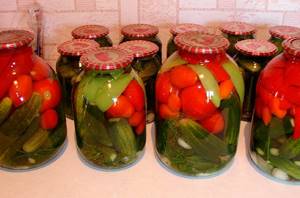
Ingredients:
- Water (it’s better to take not just filtered water, but underground, artesian, or spring water).
- Salt (coarse, crystalline, non-iodized salt is ideal).
- Sugar (sand, the finer).
- Vinegar (in recipes, its amount is calculated at 6%. Using 3% makes the vegetables too soft, 9% makes the vegetables too sour, unless adjusted for increase or decrease in volume).
- Dill (dry, umbrella).
- Horseradish (root only).
- Garlic.
- Sweet pepper (also called bell pepper). It is its inclusion in the recipe that makes the assortment taste special - just like adding chili peppers or peas.
- Actually cucumbers and tomatoes.
You will also need containers (in the recipe, calculations are made for 3-liter jars) and lids (roll-up metal ones for glassware or circular wooden ones for tubs and barrels).
Bookmark process
Sterilization of jars
The most convenient way is to place the empty jar on a wooden spoon inserted into a boiling kettle so that there is no metal-to-glass contact. The sterilization time for each jar is about 5-7 minutes.
The lids are sterilized directly in boiling water for the same time. The tubs and barrels are simply washed and dried thoroughly
Preparing the dishes
It is most convenient to place the sterilized jars side by side on a waffle towel.
Arrangement of spices and vegetables
First, the following are placed on the bottom of the cans:
- dill umbrella (1 pc.);
- horseradish (3 pieces of peeled root about the size of a finger);
- garlic (4-5 medium cloves).
Then the pepper (1 piece of shell of a large fruit, without seeds, cut into 8 slices) and the cucumbers and tomatoes themselves begin to be placed quite tightly, but so as not to crush the fruits - and the pepper slices are placed along the edges, close to the glass.
Filling with brine
It is done in 2 stages. First, pour in boiling water (leave for 7 minutes). Then pour this water into the pan, add about 100 ml more, as well as 2 tbsp. salt and 3 tbsp. Sahara.
Boil, and as soon as the first bubbles appear, pour the brine into a jar, add 1 tbsp. vinegar and roll up the lid. Obviously, when several cans are placed at once, the amount of sugar and salt poured into a pan with brine increases proportionally.
In addition, after rolling the lid, you need to turn the jar upside down and check for leaks. If it is there, try to tighten the lid with a seaming machine (if that fails, take another lid).
Stacking cans
Rolled cans are placed in rows, with the lids down, on a previously prepared woolen blanket, the free edge of which is completely covered from above.
The jars should stand in a warm place for 12 to 24 hours - after which they must be turned over, left to cool, and once completely cooled, put into a cellar or pantry (when storing using the cold method, only a fairly cold cellar or refrigerator would be suitable).
Only cucumbers with pimples and not too large in size are suitable for pickling and pickling (salad cucumbers will not crunch and will soften too much). It is also better to take tomatoes that are small and not too soft, or half-ripe.
Tomato needs
Tomatoes require artificial pollination, which should be done on warm, sunny days. At the end of the procedure, it is recommended to spray the flowers with warm water in order to stimulate the germination of pollen in the pistil. During the flowering period, tomatoes need regular ventilation. Tomatoes like dry air and water temperatures of +20°C. The average frequency of feeding is once every 5-6 weeks. The “menu” of tomatoes includes both organic and mineral fertilizers.
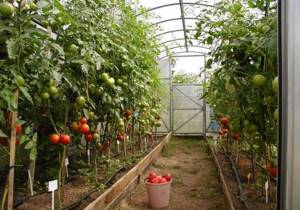
Favorable temperature conditions for the growing season and fruiting of plants correspond to +20...+22 °C during the day and +16...+18 °C at night. Optimal soil moisture is 75-80%, and the watering schedule is once every seven days with a consumption of 13-14 liters per 1 m².
Salting for the winter
In this recipe we will tell you how to preserve vegetables so that they acquire a special taste and unique aroma. Read how to pickle cucumbers and tomatoes and get down to business with us.
- Sort, wash and soak the cucumbers in clean water for a couple of hours. Wash the tomatoes and use a toothpick to make several punctures near the stem.
- Cut the hot pepper and horseradish root into small pieces.
- Peel the carrots and cut into rings.
- Process the sweet pepper, cut into several parts and remove the seeds.
- Separate the cauliflower into florets.
- Wash the cucumbers again and cut off the ends with a knife.
- Boil the required amount of water and dissolve salt in it (one tablespoon is enough for one liter).
- Place the prepared vegetables in layers in three-liter jars, adding garlic and a stalk of celery.
- Pour boiling water over the assortment, cover with sterilized lids and put in a place where they will not interfere.
- On the evening of the third day, drain the water from the jars into a suitable pan. For convenience, secure a piece of gauze to the lid using an ordinary rubber band.
- Add a little more liquid and salt to the pan (half a teaspoon per liter).
- Boil the brine and pour it into the jars.
Cover the assortment with newly pasteurized lids and turn it over until it cools. Prepared vegetables turn out very tasty and crispy, so they are a great addition to any meat, fish or poultry dishes in winter.
- For pickling, use only special varieties of cucumbers with thin skin.
- Don’t forget that pickling cucumbers and tomatoes is a creative process, and you can always change the composition of the assortment to your liking. For example, you can add beans or pieces of eggplant to these vegetables.
- Standard spices for pickling are dill, garlic, horseradish root, as well as currant, cherry or oak leaves.
How to get a harvest of cucumbers and tomatoes in one greenhouse
To achieve good results when growing cucumbers and tomatoes together, it is important to correctly arrange the seedlings according to the pattern worked out by experienced gardeners, and also follow their advice. Particular attention should be paid to the choice of varieties and conditions for their cultivation.
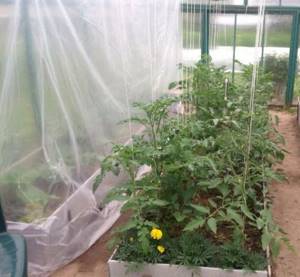
Compromise terms
The conditions for reaching a compromise include:
- Application of the zonal principle. It is better to place cucumbers in the northern part of the structure, and tomatoes in the southern part. Zones should be divided:
- a partition made of polymer film in the upper part of the greenhouse - to control air temperature and humidity;
- ground metal or plastic partition - to control soil moisture in the beds.
- Use of the internal space of the greenhouse, taking into account the selection of mutually compatible varieties: tomatoes that are immune to fungal diseases and cucumbers that are resistant to drafts.
- Construction of separate ventilation systems for plants; in the sector:
- for cultivating tomatoes, it is advisable to build 2 windows to ensure through ventilation;
- Growing cucumbers will require one window.
While caring for different species of plants, it is advisable to adhere to the following constants:
- The 24-hour temperature should be between +20…+25 °C.
- The optimal 24-hour air humidity should be 70%.
Varieties of tomatoes and cucumbers for cultivation in the neighborhood
Properly selected varieties are of great importance. In relation to tomatoes, hybrids that are resistant to high humidity and late blight deserve attention: “Gnome”, “New Year’s”, “Lyubasha”, “Soyuz 8”, “Lark”, “Dubrava”, “Metelitsa”.
When selecting cucumber varieties, pay attention to their resistance to low temperatures and drafts. The main threats to pumpkins are “powdery mildew”, “anthracosis” and “bacteriosis”, which can also be transmitted to tomatoes. Gardeners should focus on the following hybrids: “Masha”, “Benefit”, “Herman F1”, “Tom Thumb”, “Sister Alyonushka”, “Murashka”, “Crane”, “Natalie”.
Correct planting scheme for cucumbers and tomatoes
It is recommended to use the seedling method. Before planting, two ridges with a width of no more than 90 cm are formed. For both crops, separate areas should be prepared, separated from top to bottom with plastic film, as well as a sheet of slate, which prevents excessive moisture in the root system of tomatoes. The distance between different types of plants should exceed 1 meter. It is better to place seedlings in a checkerboard pattern.
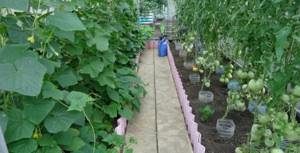
It is better to grow cucumbers in the northern part of the greenhouse, protected from drafts. Immediately after planting, they need to be fed by adding 10 ml of wood ash, 200 ml of compost and about 100 ml of hydrogel to each hole, which increases soil moisture, preventing the migration of water towards the tomatoes. The distance between cucumber seedlings should exceed 30 cm.
On the eve of planting tomatoes, it is advisable to create a drainage layer in each hole, the role of which will be well played by gravel, and also add 10 ml of superphosphate. The beds can be bulk-height, 30-35 cm higher than the soil level. The distance between tomato sprouts should exceed 40 cm. If we are talking about tall crops, it should be increased to 60 cm. The depth of planting tomatoes should correspond to the place where the first leaf grows.
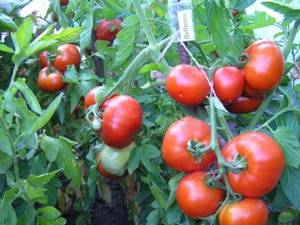
Dubrava
Proper care of joint plantings
General requirements include:
- regular treatment of plants with special compounds in order to combat insect pests, as well as prevent infectious diseases;
- control over:
- temperature and humidity inside the greenhouse;
- frequency of fertilizing of grown varieties.
cucumbers
Cucumbers are a moisture-loving crop. On the eve of watering, the water must be settled, and during irrigation, a sprayer must be used for the green part of the plant. The optimal greenhouse humidity level is 85%, and the air temperature is +22...+28 °C.
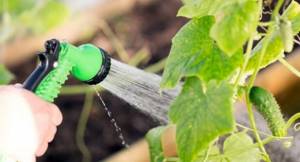
It is important to remember that drafts are detrimental to cucumbers. Seedlings should be fed regularly and watered frequently, but not abundantly. The average number of feedings during the growing season is 6. After the fruits appear, the intensity of irrigation must be increased. The recommended width of passages is at least 40 cm.
Tomatoes
It is better to cultivate tomatoes in polycarbonate structures. The desired parameters of the beds are 90*90*40 cm. The passages between the beds should exceed 60 cm.
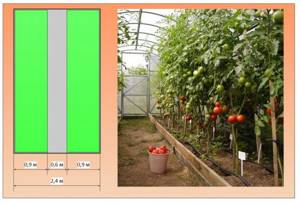
10-14 days after planting the seedlings, be sure to add soil to the holes. At this time, the plant should not be watered abundantly. As the stem grows, it is tied to a trellis.
In addition to watering, tomatoes need systematic ventilation (for these purposes, it is recommended to separate the neighboring cucumber crop with film). The average number of feedings during the growing season is 4. Practice shows that the most promising is an ovary of seven racemes with inflorescences. It is recommended to remove excess stepsons.
Film separation
Polyethylene is stretched from the roof of the greenhouse to the ground, including the division of the beds. Each sector has its own microclimate. Tomatoes like regular ventilation.
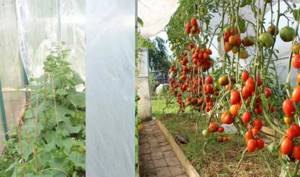
Separate landing
This method involves planting tomatoes on the south side, and cucumber seedlings on the north. The pumpkin culture is more suitable for a cool climate, which reduces the amount of evaporated moisture.
With corn
What to take:
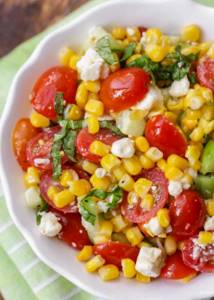
How to do:
Let the salad of tomatoes, cucumbers and feta cheese brew for about half an hour, then serve.
Tips from Mister Summer Resident
Some advice from our portal https://mrdachnik.com. The practice of horticulture and plant growing shows that to increase the yield of crops one should:
- ensure that the daily range of air temperatures is less than +5 degrees;
- Orient the greenhouse from north to south, while:
- plant cucumbers on the north side;
- allocate the southern part to tomatoes;
- choose self-pollinating varieties whose flowering period does not coincide;
- During the day, during flowering, shake the plants to promote self-pollination.

